
The 1948 Alfa Romeo 6C 2500 Competizione (Sperimentale) was built as an experimental racing car for the Alfa racing team. In 1950 Juan Fangio drove the Competizione in the Mille Miglia and finished in second place. It has a rich racing history and was raced until 1952. Unique features include larger valves, competition head and dry sump. The only postwar dry sump cars are Competizione 92001 and the 3-litre D150. A three-year restoration was completed by Red Line Restoration in Black Rock, Connecticut and overseen by Peter Marshall, noted Alfa Historian.
Design and Features
Engine: The Alfa Romeo 6C 2500 Competizione is powered by a 2.5-liter inline-six engine, producing around 145 horsepower. This engine featured advanced technology for its time, including a DOHC (dual overhead camshaft) configuration.
Chassis and Suspension: The car was built on a steel tube-frame chassis, which provided a strong yet lightweight structure. The suspension system included independent front suspension with coil springs and a live rear axle with leaf springs, ensuring a balance between handling and ride comfort.
Body Styles: It was available in various body styles, including coupes and roadsters. The bodies were often designed and built by renowned coachbuilders such as Touring, Pinin Farina (later Pininfarina), and Zagato. The Competizione versions were typically lightweight, aerodynamic, and tailored for racing.
Design: The design is sleek and aerodynamic, reflecting the post-war automotive design trends. The low-slung body, long hood, and streamlined fenders give the car an elegant yet aggressive appearance.
Racing Heritage
Competition Success: Specifically designed for racing, and it saw considerable success in various motorsport events. Notable achievements include class wins and high placements in prestigious races such as the Mille Miglia and the Targa Florio.
Driver’s Car: Known for its excellent handling, powerful engine, and lightweight construction, the 6C 2500 Competizione was a favorite among racing drivers of the era. It combined speed with agility, making it a competitive vehicle on both road and track circuits.
Historical Significance
Post-War Innovation: The Competizione was one of the first major models produced by Alfa Romeo after World War II. It represented a significant step forward in automotive design and engineering, showcasing Alfa Romeo’s resilience and commitment to innovation.
Legacy: The success and prestige of the 6C 2500 Competizione helped solidify Alfa Romeo’s reputation as a manufacturer of high-performance, beautifully designed sports cars. It is a direct ancestor of later iconic models, such as the Alfa Romeo 8C Competizione.
You may purchase a print of the 1948 Alfa Romeo 6C 2500 Competizione (Sperimentale) in our dElegance 2011 online gallery.



